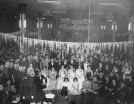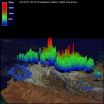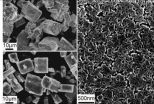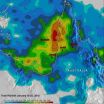(Press-News.org) COLUMBUS, Ohio—It weighs half as much as a sports car, and turns on a dime—so its no surprise that the electric car being developed at Ohio State University needs an exceptional traction and motion control system to keep it on the road.
With four wheels that turn independently, each with its own built-in electric motor and set of batteries, the experimental car is the only one of its kind outside of commercial carmakers' laboratories.
"It is considered one of the promising future vehicle architectures," said Junmin Wang, assistant professor of mechanical engineering and Director of the Vehicle Systems and Control Laboratory at Ohio State. "It would make a good in-city car—efficient and maneuverable, with no emissions. Our task is to make a robust control system to keep it safe and reliable."
In a paper in the January 2013 issue of the journal Control Engineering Practice, his team described the car's ability to follow a specific trajectory.
In tests on good road conditions at the Transportation Research Center in East Liberty, Ohio, the car followed a driver's desired path within four inches (10 cm). To test slippery road conditions, the researchers took the car to an empty west campus parking lot on a snowy day. There, the car maneuvered with an accuracy of up to eight inches (20 cm), and the vehicle traction and motion control system prevented "fishtailing" through independent control of the left and right sides of the car.
Wang characterized these results as more accurate than a conventional car, though the comparison is hard to make, given that conventional cars are much more limited in maneuverability by the transmission and differential systems that link the wheels together mechanically. The four independent wheels of the electric car give drivers greater control and more freedom of movement.
The experimental car also weighs half as much as a conventional car—only 800 kg, or a little over 1,750 pounds—because it contains no engine, no transmission, and no differential. The researchers took a commercially available sport utility vehicle chassis and removed all those parts, and added a 7.5 kW electric motor to each wheel and a 15 kW lithium-ion battery pack. A single electrical cable connects the motors to a central computer.
One hundred times a second, the onboard computer samples input data from the steering wheel, gas pedal and brake and calculates how each wheel should respond. Because the wheels are independent, one or more can brake while the others accelerate, providing enhanced traction and motion control.
In fact, a driver who is accustomed to conventional cars would have a difficult time driving a car of this experimental design, known as a "four-wheel independently actuated" (FIWA) car without the help of the vehicle motion and traction control system. With its ability to turn sharply and change direction very quickly, the car could be hard to control. Wang has tried it.
"Without the controller, it's very hard to drive. With the controller, it's quite nice—quiet, and better control than commercial four-wheel drive," he said.
The main challenge for his team—which consists of bachelor's, master's, and doctoral students as well as a few local high school students—is to make the whole traction and motion control system energy-efficient and fault-tolerant, so if one wheel, motor or brake malfunctions, the others can compensate for it and maintain safety. It's a situation analogous to a multi-engine plane losing an engine: the other engines have to adjust thrust and angle to keep the plane safe and on course.
Future work will concern the FIWA car's energy efficiency for increasing its travel range in urban environments, and optimizing the weight distribution in the car.
Wang estimates that we won't see a FIWA car on the road for another 5-10 years, as researchers continue to develop new algorithms to control the car more efficiently and add more safety features.
The coauthor on the paper was Rongrong Wang, a doctoral student in mechanical engineering, and the team's high school participants came from the Columbus Metro School, a state of Ohio public STEM (science, technology, engineering, math) high school open to students from around the state.
INFORMATION:
This research was supported by Junmin Wang's awards from the Office of Naval Research Young Investigator Program (2009) and the National Science Foundation's Faculty Early Career Development Program (2012); the Honda-OSU Partnership program; and the OSU Transportation Research Endowment Program.
Contact: Junmin Wang, (614) 247-7275; Wang.1381@osu.edu
Written by Pam Frost Gorder, (614) 292-9475; Gorder.1@osu.edu
Editor's note: a photograph of the experimental FIWA car is available from Pam Frost Gorder.
Motion control keeps electric car's 4 wheels -- and 4 motors -- on the road
2013-01-24
ELSE PRESS RELEASES FROM THIS DATE:
Children's complex thinking skills begin forming before they go to school
2013-01-24
New research at the University of Chicago and the University of North Carolina at Chapel Hill shows that children begin to show signs of higher-level thinking skills as young as age 4 ½. Researchers have previously attributed higher-order thinking development to knowledge acquisition and better schooling, but the new longitudinal study shows that other skills, not always connected with knowledge, play a role in the ability of children to reason analytically.
The findings, reported in January in the journal Psychological Science, show for the first time that children's ...
SNPs associated with breast cancer risk alter binding affinity for pioneer factor FOXA1
2013-01-24
(Lebanon, NH)— Dartmouth scientists showed that more than half of all the SNPs associated with breast cancer risk are located in distant regions and bound by FOXA1, a protein required for estrogen receptor-α (ER) function according to a paper published in the journal Nature Genetics in November.
Jason Moore, PhD, a Third Century Professor of genetics, director of the Institute for Quantitative Biomedical Sciences, and associate director for bioinformatics at Dartmouth-Hitchcock Norris Cotton Cancer Center, and other researchers used a new methodology that combines ...
Tall and thin not so great for lung disease
2013-01-24
Tall, thin women face a greater risk of infection with nontuberculous mycobacteria (NTM), cousins of the organism that causes tuberculosis, according to researchers at National Jewish Health. Women with NTM infections also showed a weakened immune response associated with their fat cells, in a paper published in the Jan. 15, 2013, issue of The American Journal of Respiratory and Critical Care.
"Nontuberculous mycobacteria are widespread in the environment, yet only some people develop infections," said Edward Chan, MD, senior author and professor of medicine at National ...
Modifications of a nanoparticle can change chemical interactions with cell membranes
2013-01-24
Researchers at Syracuse University's Department of Biomedical and Chemical Engineering at L.C. Smith College of Engineering and Computer Science are studying the toxicity of commonly used nanoparticles, particles up to one million times smaller than a millimeter that could potentially penetrate and damage cell membranes.
In a recent article published along with cover art in the leading journal Langmuir entitled "Effects of nanoparticle charge and shape anisotropy on translocation through cell membranes," researchers Shikha Nangia, assistant professor of biomedical and ...
Planning for bacteria in cancer patients may help hospitals fight infections
2013-01-24
What cancerous conditions lead to what kinds of bacterial infections? If doctors knew, they could predict which patients would likely benefit from pre-treatment with certain kinds of antibiotics. A University of Colorado Cancer Center study published in this month's issue of the International Journal of Infectious Diseases shows the answer: E. coli and Klebsiella pneumoniae are especially prevalent in patients with lung and GI cancers, more so for Klebsiella if these patients have been treated previously with aminopenicillins.
"These are really dangerous infections. You ...
'Invisible' Filipino history in Annapolis documented by UMD researchers
2013-01-24
COLLEGE PARK, Md. – Filipinos have been an invisible minority in Annapolis, Maryland for more than a century. Now, researchers at the University of Maryland are using oral histories as a way to flesh out their life and times – documenting the incredible challenges they faced – and successes they celebrated.
After the Spanish-American War, the Philippines became a U.S. territory. Filipinos were brought to Annapolis – home of the Naval Academy – to serve as desk interns, fire fighters, construction laborers, messmen and stewards. In many cases, the Naval Academy replaced ...
NASA catches the very brief life of Tropical Cyclone Peta
2013-01-24
VIDEO:
This is a NASA TRMM satellite flyby of Tropical Cyclone Peta in the South Indian Ocean. TRMM revealed that rain was falling at a rate of up to 94 mm...
Click here for more information.
Infrared data from NASA's Aqua satellite has shown that soon after a low pressure system in northwestern West Australia became Tropical Storm Peta, it made landfall and started to fall apart.
Early on Jan. 22, the Joint Typhoon Warning Center (JTWC) gave System 93S a high chance for ...
ORNL research paves way for larger, safer lithium ion batteries
2013-01-24
OAK RIDGE, Tenn., Jan. 23, 2013 -- Looking toward improved batteries for charging electric cars and storing energy from renewable but intermittent solar and wind, scientists at Oak Ridge National Laboratory have developed the first high-performance, nanostructured solid electrolyte for more energy-dense lithium ion batteries.
Today's lithium-ion batteries rely on a liquid electrolyte, the material that conducts ions between the negatively charged anode and positive cathode. But liquid electrolytes often entail safety issues because of their flammability, especially as ...
NASA sees massive rainfall totals from Tropical Storm Oswald
2013-01-24
Tropical Storm Oswald's heavy rains have caused flooding in Queensland, Australia and NASA's TRMM satellite measured almost two feet of rain fell in certain areas.
Tropical cyclone Oswald's sustained winds have never been greater than 35 knots (~40.2 mph) but the storm's extreme rainfall has resulted in widespread flooding in Australia over northern Queensland. Many roads have been reported flooded resulting in some communities being cut off.
NASA's Tropical Rainfall Measuring Mission (TRMM) is a satellite that can measure rainfall from space. TRMM-based satellite precipitation ...
Experts propose overhaul of ethics oversight of research
2013-01-24
The longstanding ethical framework for protecting human volunteers in medical research needs to be replaced because it is outdated and can impede efforts to improve health care quality, assert leaders in bioethics, medicine, and health policy in two companion articles in a Hastings Center Report special report, "Ethical Oversight of Learning Health Care Systems." One of the authors calling for a new approach is the main architect of the current ethical framework.
Seven commentaries in the publication, written by leaders with national responsibility for ethical oversight ...




